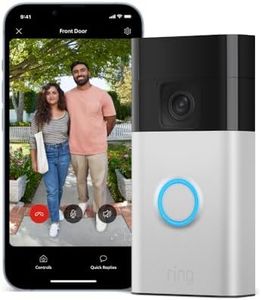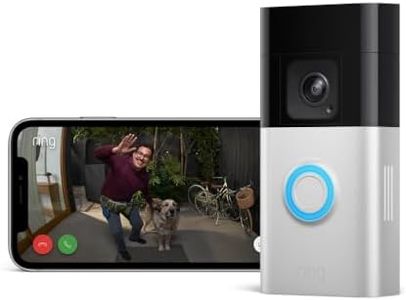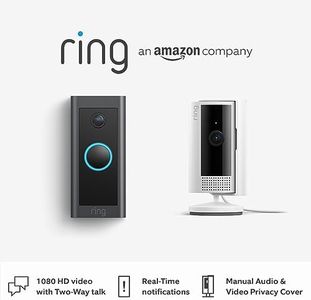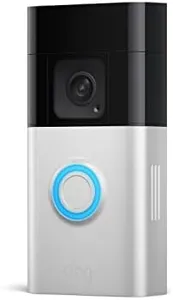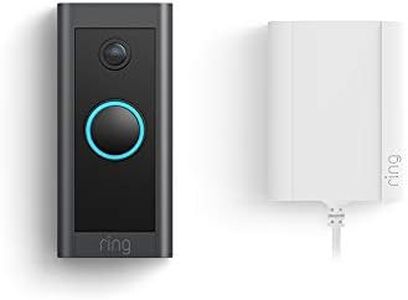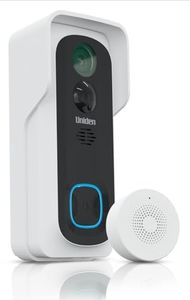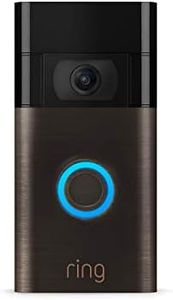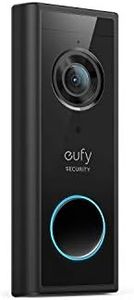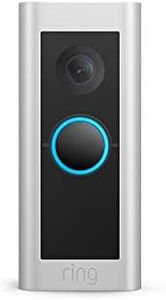We Use CookiesWe use cookies to enhance the security, performance,
functionality and for analytical and promotional activities. By continuing to browse this site you
are agreeing to our privacy policy
10 Best Ring Doorbells
From leading brands and best sellers available on the web.By clicking on a link to a third party's website, log data is shared with that third party.
Buying Guide for the Best Ring Doorbells
Choosing a ring-style video doorbell is all about finding the right match for your home's security and convenience needs. Video doorbells let you see, hear, and speak to visitors at your door, even when you're not home. To pick the best one, you'll want to consider how it fits with your lifestyle, your existing doorbell setup, and your expectations for features such as video quality, motion detection, and ease of installation. Understanding the key specifications will help you make an informed choice that you'll be happy with for years.Video ResolutionVideo resolution tells you how clear the image from the doorbell camera will be. It's usually measured in HD (720p), Full HD (1080p), or even higher. Higher resolution gives a sharper and more detailed view of visitors and packages left at your door—helpful for identifying faces or reading details. Entry-level models might offer basic HD, which can be enough if you just want to see if someone's at your door. Full HD or higher is better if you want more clarity, especially if the area near your door is busy or you want clearer footage for security reasons. Choose the resolution that matches how much detail you want to see and how important image quality is to you.
Power SourceRing-style doorbells can be powered by batteries, by wiring into your existing doorbell system, or a combination of both. Battery-powered models are easier to install and can go almost anywhere, but you'll need to recharge or replace batteries every few weeks or months. Hardwired models connect to your home's doorbell wiring, so you never have to worry about recharging, but installation can be more involved. Think about where you want to install the doorbell and whether you're comfortable with some DIY wiring, or if you prefer the flexibility and simplicity of a battery-powered unit.
Motion DetectionMotion sensors help the doorbell detect people or movement near your door and send you alerts. Some models offer basic motion detection, while others let you customize detection zones or use more advanced technology to recognize people versus cars, animals, or passing shadows. If you live on a busy street or have lots of activity near your door, you'll want a model that lets you fine-tune what triggers an alert and avoid too many unnecessary notifications. If you rarely have visitors or only need basic warnings, simpler motion detection may be enough.
Field of ViewThis spec describes the width and height of the area your doorbell camera can see, usually measured in degrees. A narrow field of view (around 90–120°) captures just what's directly in front, suitable for doors set back from the street. A wider field of view (around 150–180°) can show more of your front yard, driveway, or porch, which helps to see if packages are left or to spot visitors approaching from the side. Consider how much area you want to monitor and if there are any blind spots you want to avoid when deciding on the field of view.
Two-Way AudioTwo-way audio lets you talk to visitors through your phone or smart device and lets them respond. This is helpful for giving instructions to delivery people, greeting friends, or even deterring unwanted visitors. Most video doorbells include this, but there can be differences in sound quality, lag, and noise reduction. If you often communicate with people at your door when you're away, look for clear, reliable audio as a key feature.
Night VisionNight vision allows the doorbell camera to see and record clearly even in low light or darkness. It uses infrared or enhanced low-light sensors. Some basic models may only provide a basic black-and-white picture at night, while more advanced options offer sharper and brighter nighttime images. If your entryway is poorly lit or you want to monitor your door 24/7, prioritize good night vision.
App Integration and Smart Home CompatibilityThis refers to how the doorbell connects with your smartphone and other smart home devices. Some doorbells offer simple alerts and live video through an app, while others can integrate with voice assistants or smart locks for extra functionality. Think about how much you want your doorbell to 'talk' to other tech in your home—if you already use smart home devices, check that the doorbell works smoothly with those you have or might add in the future.
Cloud Storage and SubscriptionMany video doorbells save video clips to cloud storage, often requiring a monthly or yearly subscription fee. Without a subscription, you may only get live video and basic notifications, while a subscription gives access to video history and sharing. Decide if it's important to have recorded footage you can review later, and be aware of extra costs tied to the features you need.
Weather ResistanceSince doorbells are used outdoors, they need to withstand rain, snow, heat, and dust. Look for weather-resistant or weatherproof ratings. If you live in a place with extreme weather, make sure your chosen model is engineered to handle those conditions and keep working reliably all year round.
